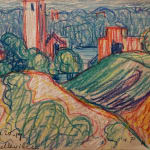
 Framed image
Framed image
 Verso
Verso
 Main image
Main image
Oscar Bluemner American, 1867-1938
4.75 x 6 in
Further images
Provenance
Sid Deutsch Gallery, NY;Private Collection;
Madron Gallery, Chicago, IL;
Acquired from the above by present owner;
Exhibitions
JC Gallery, London, James Ward Presents: Seven Americans, 2024The Modernist painter Oscar Bluemner was born in Hanover, Germany, in 1867. As a young man, he followed in the architectural careers of his father and grandfather. In the early 1880s, he studied architecture and painting at the Royal Academy of Design in Berlin and then traveled to America, hoping to receive an architectural commission with the World Exposition in Chicago in 1893. Finding little success there, he went to New York, where he began to paint, and his work was well received under the sponsorship of Alfred Stieglitz.
In 1916, the artist was included in the prestigious Forum Exhibition of Modern American Painters in New York, and shortly thereafter, he moved to New Jersey, first settling in Bloomfield and then relocating in 1924 to Elizabeth. During the first eight years of this long period in New Jersey, the artist suffered incredible poverty and was forced to rework earlier paintings, as he could not afford fresh canvas. Nevertheless, he was submerged in his art, sketching almost daily and reading numerous books on theory that ranged from Oriental and Symbolist aesthetics to the visionary philosophies of Henri Bergson, Claude Bragdon and Osvald Spengler.
Bluemner’s own words best describe his work from this period: “I prefer the intimate landscape of our common surroundings [for] we carry into them our feelings of pain and pleasure, our moods . . . I am unable to let the simple objects of a scene, a house, a tree, a sky or water be my actors . . . and use shapes resembling theirs to correspond to the respective tones of any personal color theme my imagination conceives. That is, I do not paint an “impossible” nature, but rather an aesthetically-psychologically possible free creation for play upon the spectator’s soul.”
In 1926, Bluemner’s wife Lina died suddenly, and this tragic event prompted him to move with his children to South Braintree, Massachusetts. There, at the age of fifty-nine, the artist entered the final and most prolific phase of his career during which he explored male and female principles, attempted to identify the various dimensions of experience (the physical, the emotional/intellectual/ and the spiritual), and searched for transcendental truths revealed through the senses and the psyche. These late works are among the artist’s most complex. Nevertheless, the 1930s witnessed a decline in the artist’s health and an increasing sense of private desperation that coincided with the national crisis of the Depression. In 1938, Bluemner committed suicide.
This drawing titled 'Belleville, NJ' was created after the artist decided to pursue painting full time, instead of his first passion, architecture. The description of the drawing inscribed on the verso in graphite seems to be notes the artist created for possible future work based on the drawing.
The work contains vibrant colours, Bluemners’ trademark blues and reds are scrawled across the image aside chromatic greens, yellows and oranges. Bluemner was influenced by European modernist artists, who sort to use colour to find new ways of expressing emotions through their work. In 1912, four years prior to creating this piece, he embarked on an intensive seven-month trip to Europe. This venture proved to be expansive and his study of new trends in German art, particularly expressionism and futurism broadened his ways of making and thinking. This expressionist turn is apparent within ‘Belleville, NJ’ as his emotive use of colour is reminiscent of his European peers Van Gogh, Wassily Kandinsky and Franz Marc. The title informs the viewer of the works locality, ‘Belleville New Jersey’, Bluemners home. He created this drawing a year after moving there, the excitement he felt to be making work in a new environment can be decoded from the excitable mark making. Passionate swirls and bold lines carve into the paper with intensity. Under close observation, subtle indentations in the paper can be seen in the top left-hand corner – an illustration of the pressure with which Bluemner applied the crayon to the surface. Bluemner embraced life in New Jersey, despite financial struggles, and enjoyed escaping the fast paced life of New York. This eagerness to move and reconnect to nature was a popular theme in many of the works of the other artists in Stieglitz circle, such as O’Keefe and Dove.




